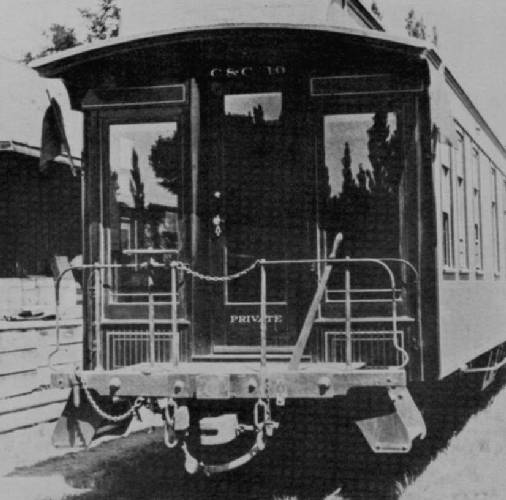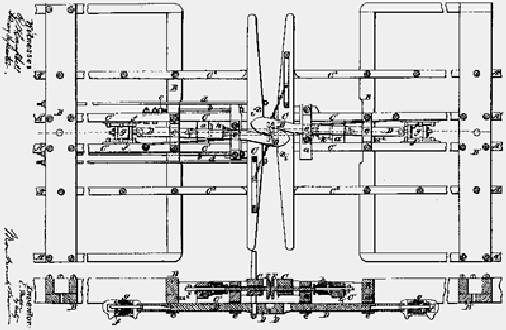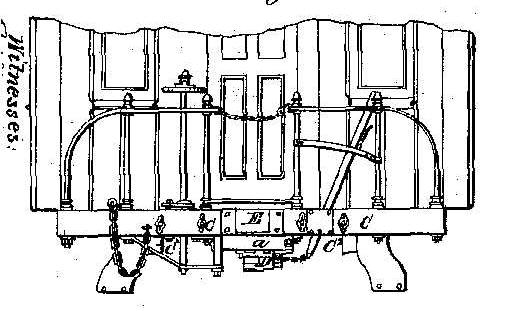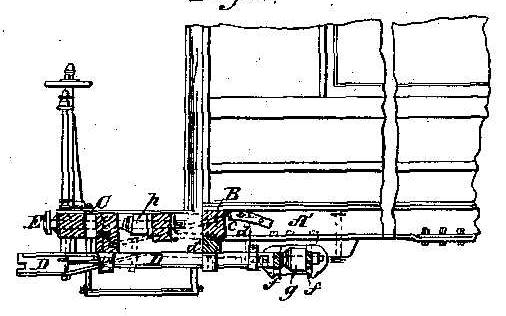The Miller HookThe passenger car coupler of preference before Major Janney did his thing.
Below we present three drawings from Millers patent application. The complete description, with drawings, can be found at the United States Patent and Trademark Office Home Page under U.S. Patent #56,594, dated July 24, 1866. Similar drawings may be found at Forney-359/61. The first drawing shows the mechanism from the bottom, looking up at the floor of the car. Because of this, the hook looks like a right hand with the fingers crimped. But when viewed from above, it is actually like a left hand with the fingers crimped.
The third drawing shows how the hook and buffer are positioned beneath the platform to simultaneously hold the cars together and hold them apart.
History: For most of the nineteenth century, the link and pin coupler was the standard coupler used to hook together freight cars. It consisted of a tube-like body that received an oblong link. During coupling, a brakeman had to stand between the cars as they came together and guide the link into the coupler pocket. Once the cars were joined, a pin was inserted into a hole a few inches from the end of the tube to hold the link in place. The link and pin coupler, though widely used, ultimately proved unsatisfactory.
Little progress was made at solving the coupler problem until inventors totally discarded the old technology and applied fresh and original thinking. One who did this was Col. Ezra Miller.
Miller was born at Bergen, New Jersey, in 1812 and educated as a civil, topographical
and mechanical engineer. At 21 he enlisted in the 2nd regiment horse artillery
of the New York militia, where he obtained the rank of full colonel after ten
years. He married at 29, and settled at Fort Hamilton, NY. In 1848 he moved his
family to Rock County, Wisconsin, where he was employed in the survey of state lands
for the new state of Wisconsin, and also as a farmer. Following these early
years with the state survey, he engaged in railroad survey and construction work
with the Chicago & North Western Railway Co. In 1851 he was commissioned a
colonel in the Wisconsin militia, and in 1852 he was elected to the Wisconsin
Senate, serving one term. Millers inventions were more than simply a coupler, but a combined passenger car platform, coupler, and buffer design, generally referred to as the Miller Platform. He began with a stronger end platform, moved up and made an integral part of the coach's frame to better transfer axial motion through the cars when starting, stopping, or operating the train. Mounted below the platform was a combination of semi-automatic coupler (the hook) and buffer, assuring tight connection between cars and providing a system to absorb the end impact forces between the cars. Miller was not the first to come up with a hook-type coupler, but he did manage to work out the engineering details and successfully market a device that the railroad industry would accept -- accept, that is, for passenger equipment. The Miller Hook had become a national standard on passenger cars by about 1875, but it was rarely applied to freight equipment. Poor-324 says the Colorado Railway Commission Report for 1885 said the Miller automatic coupler was standard equipment for all passenger cars of the Denver South Park & Pacific as of that date. Why didnt the railroads simply apply Miller Hooks to the freight car fleet?
It was a known and tested mechanism. Thousands were in daily service. There was
nothing strange or unproved about it. Maybe it was the cost; Miller's royalty
fees were fairly stiff. Maybe the buffer arrangement could not be made to fit
under the ends of a freight car unless platforms were added. It is more than
likely that the Miller Hook was simply considered obsolete by 1885, its
technology having been replaced by that of the new knuckle-type couplers (Janney
got his first patent in 1873).
|
|||||||||||||||||||||||||||||||||



